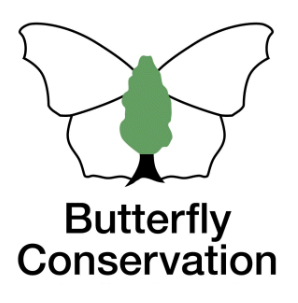Brown Argus
Brown Hairstreak
Chalkhill Blue
Clouded Yellow
Comma
Common Blue
Dark Green Fritillary
Dingy Skipper
Essex Skipper
Gatekeeper
Green Hairstreak
Green-veined White
Grizzled Skipper
Holly Blue
Large Skipper
Large White
Marbled White
Meadow Brown
Orange-tip
Painted Lady
Peacock
Purple Emperor
Purple Hairstreak
Red Admiral
Ringlet
Silver-washed Fritillary
Small Blue
Small Copper
Small Heath
Small Skipper
Small Tortoiseshell
Small White
Speckled Wood
Wall
White Admiral
White-letter Hairstreak
Extinct/rare immigrants
Marbled White
Melanargia galathea
General Distribution and Status
The Marbled White is widespread and locally abundant in the southern half of England and Wales although it is much scarcer in the east. It is also found in Yorkshire. The butterfly has been one of our success stories in the last 50 years as it has expanded northwards and eastwards. Earlier in the 20th century until the 1970s its range had retreated as a result of destruction of grassland habitat and intensification in agriculture. Probably due to the warmer summers in the last few decades the insect has been able to disperse to colonise new sites. Since the 1970s distribution and abundance at monitored sites in Britain have increased (Brereton et al., Fox et al.). In Hertfordshire and Middlesex, the range has expanded at a similar rate but the increase in abundance is more pronounced since 1996 (Wood, 2016). The spread started from the west in the Tring area and is now found in most of Hertfordshire including the far north-east where many new colonies were found in 2017 (Wood, 2018). However, numbers have dropped recently probably due to inclement weather. It appears that the butterfly is more able to adapt to breed on road verges, field margins and woodland clearings as well as continuing to thrive on calcareous grasslands, if the grass sward is kept reasonably tall.
| United Kingdom | Herts & Middx | |||
| Distribution | 1976-2019 | -11% | 1980-2015 | +27% |
| Average 10-year trend | -2% | 2006-2015 | +49% | |
| 2024 since 2015-19 | +50% | |||
| Abundance | 1976-2024 | +81% | 1980-2015 | +965% |
| 2015-2024 | -10% | 2006-2015 | +389% | |
| 2023-2024 | -38% | 2024 since 2015-19 | -58% | |
UK distribution map
UKBMS Species summary
Habitat Requirements
This species inhabits unimproved grasslands, woodland rides, road verges, railway cuttings and waste ground where the grasses are maintained at a tall height. Management is required to ensure that the vegetation is not too overgrown to allow a good mix of fine grasses to grow and taller ones to form tussocks (Asher et al.).
Larval Foodplants
Red Fescue Festuca rubra. Other plants occasionally used include Sheep's Fescue F. ovina, Timothy Phleum pratense, Cock's-foot Dactylis glomerata and Tor Grass Brachypodium pinnatum (Sawford).
Adult Food Sources
Buddleia Buddleja davidii (14), Knapweed Centaurea sp. (13), Thistle Cirsium sp. (13), Field Scabious Knautia arvensis (12).
Historical Records
In the early years the butterfly was restricted to chalky areas, mainly in the west of the county and there are no reports from the Stevenage area until 1983 when one was seen at Aston (Sawford).
Local Distribution and Abundance
As indicated on the map, the Marbled White is widespread in the Stevenage area and has now been recorded in each tetrad during the survey. Good news from an observer who found six specimens in the Knebworth area (TL22K) on 19 July 2021 where it was not reported since July 2004. The best sites are Shackledell Grassland, Great Ashby Park and Knebworth Park where at least 50 specimens might be seen on one visit during the peak flight period in July. Another site, near High Wood on the Walkern Road, saw over 100 specimens on two occasions in late June 2022. Numbers overall dropped slightly in 2024.

Stevenage (South Fairlands Valley Park) transect 1993-2025
A dramatic increase in the number of Marbled White has occurred in the middle part of the last decade as shown on the chart although a significant reduction resulted in 2018. Only one was seen before 2006; on 16 July 2000. The fine summer of 2006 appeared to have allowed some specimens to disperse from probably the west, perhaps Knebworth Park where colonies were already well established, and colonise Fairlands Valley Park. Some suitable management of Shackledell Grassland in the early part of the last decade has benefited this butterfly and in 2014 over 100 specimens were counted on 1 July on this small site. As noted above, 2018 was not a particular good year because Shackledell Grassland, where the vast majority of specimens were counted, was severely cut in the previous winter which could have killed off many of the hibernating caterpillars.

Knebworth Park transect 1996-2010 and 2017-2025
The first Marbled White arrived in 1999 and numbers have been steadily increasing since then although there was a significant fall in 2020. Over 100 individuals were counted on 12 July 2019, with the vast majority being found in the north-western section of the park. However, in this section of the park, the presence of numerous deer droppings in 2020 suggests excessive deer grazing and probably a large proportion of larvae were predated by the deer. Drought earlier in the year may also have contributed to the decline.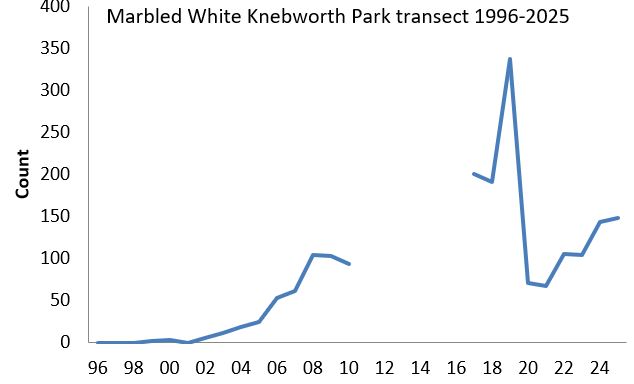
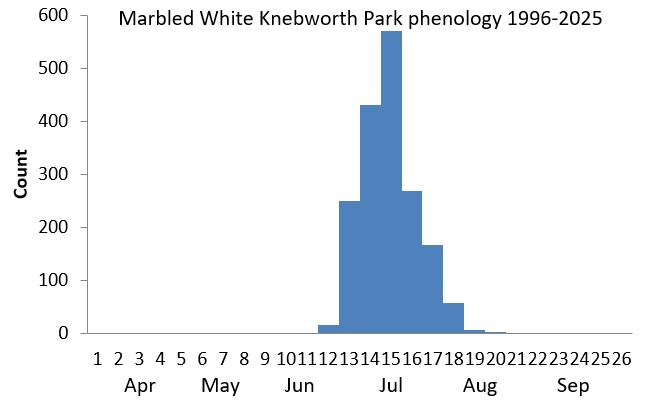
Knebworth Woods transect 2017-2025
Numbers increased in the first three years, but decreased since 2020 although 2025 saw a recovery. Most specimens are seen in the meadow at Norton Green Common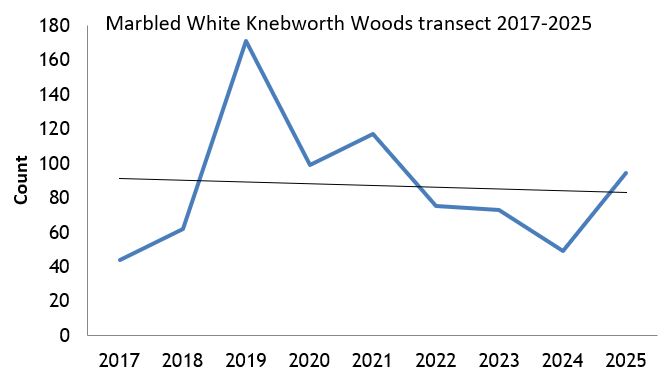
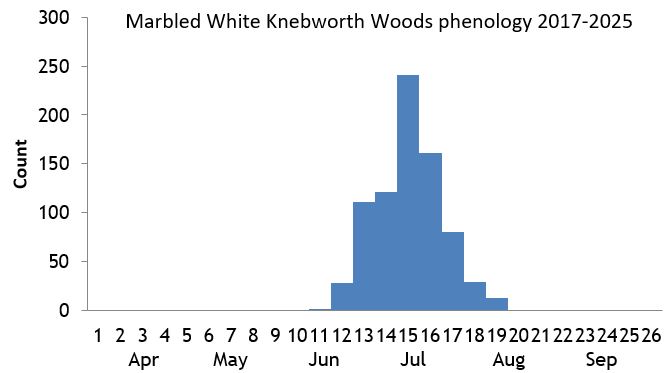
Pryor's Wood transect 2000-2022
Since the first arrivals in 2006 the Marbled White has been seen in mostly increasing numbers each year with 19 recorded on 26 June 2020 but although few (6) were seen in 2021, it made a slight recovery in 2022.Life History
Earliest date: 6 June 2015 at GlaxoSmithKline, Stevenage
Latest date: 17 August 2004 at Knebworth Park
Only one generation
is produced each year with the butterfly on the wing between the middle of June and early August, and a peak usually in the first week of July.
Mated females sit on tall stems and release the eggs on tall vegetation - they do not lay on the foodplant. After the larva eats the eggshell it enters
hibernation then begins feeding in the spring. The pupa is formed on the ground.
Behaviour/Observation notes
The Marbled White is very conspicuous and hard to miss when in flight which is slow and flapping. It is easy to approach when basking on grass or flower-heads. For taking pictures of the uppersides visit a known site in the morning, late afternoon or in dull weather.
Variations/Aberrations
The aberrations of this butterfly are very rare and none have been reported in Hertfordshire.
Find out more on the UK Butterflies website
References

Norton Green Common 30 Jun 2017 (m)

Watery Grove 4 Jul 2016 - top (f) and bottom (m)
Copyright © Peter Clarke 2017 - 2023. All rights are reserved.
